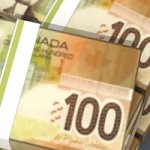USD/CAD reached 1.0815 on Economic Concern

The Canadian dollar sank to a five-week low before reports next week that are forecast to show the nation’s economy is lagging behind that of the U.S., its biggest trading partner.
The currency fell for a second day against its U.S. counterpart, dropping versus all of 16 major peers. The Bank of Canada cut its growth forecast on July 16 and said the nation’s economy won’t reach full potential until mid-2016. Data due next week are projected to show U.S. employment and gross domestic product climbed. Hedge-fund managers and other large speculators stayed bullish on Canada’s dollar.
“The economic numbers are likely to continue to be a drag on the Canadian dollar,” David Doyle, a strategist at Macquarie Capital Markets in Toronto, said in a phone interview. “We’re seeing quite a bit of momentum in the U.S. labor market.
The loonie, as the Canadian dollar is known for the image of the aquatic bird on the C$1 coin, depreciated 0.6 percent to C$1.0812 per U.S. dollar at 5 p.m. Toronto time. It reached C$1.0821, the weakest level since June 20, and has declined 0.8 percent on the week. One loonie buys 92.49 U.S. cents.
Canada’s dollar weakened beyond its 50-day average, at C$1.0790, for the first time since June 9, a sign to some traders that there may be momentum for further losses. It approached its 200-day moving average, at C$1.0829, which it last traded weaker than on June 20.
Net Longs
Futures bets by large speculators for the loonie to gain versus the U.S. dollar increased for a fourth week, reaching the most since February 2013. Net long positions, or bets the Canadian currency will strengthen, rose to 20,581 contracts in the week ended July 22, the most since February 2013, from 15,621 the previous week, according to data released today by the Washington-based Commodity Futures Trading Commission.
Canada’s government bonds rose for the first time in three days, with the yield on the benchmark 10-year security falling to the lowest level in 13 months. The yield decreased four basis points, or 0.04 percentage point, to 2.12 percent. The price of the 2.5 percent security due in June 2024 gained 35 cents to C$103.39.
Crude oil, Canada’s biggest export, fell for the week. Futures declined 1.1 percent to $101.97 a barrel in New York. Crude sank today as much as 1.1 percent before paring the drop as intensifying turmoil in Ukraine raised tension between Russia and western nations.
The U.S. dollar gained versus most major peers amid signs the world’s biggest economy is accelerating.
U.S. GDP
U.S. GDP expanded an annualized 3 percent from April through June, rebounding from a 2.9 percent contraction in the first quarter, economists in a Bloomberg survey forecast before a report due July 30. U.S. employers added 231,000 jobs in July, exceeding 200,000 for a sixth month, economists forecast in a separate survey before data due Aug. 1.
Other data are forecast to show U.S. consumer confidence rose in July.
‘‘The market is positioning itself for a busy U.S economic calendar next week,” Dean Popplewell, head analyst in Toronto at the online currency-trading firm Oanda Corp., said via e-mail. “The loonie has little support from the Canadian economic agenda until the end of the month, when we get GDP data for May. It remains at the mercy of the dollar’s moves.”
Canadian Economy
Canada’s economy grew 2.3 percent in May from a year earlier, economists estimated before the nation’s statistics agency issues the data on July 31. It increased 2.1 percent in each of the two previous month after reaching a 17-month high of 2.9 percent in October.
Canadian employment unexpectedly shrank in June, data showed on July 11. The nation lost 9,400 jobs, versus a forecast for a gain of 20,000, and the unemployment rate increased to 7.1 percent, from 7 percent in May.
The loonie has swung this year between a 4 1/2 year low and a six-month high as investor speculation fluctuated on when the Bank of Canada might raise interest rates, which have been held at 1 percent since 2010 to support the economy.
The currency slumped in March to C$1.1279, the weakest level since July 2009, after central-bank Governor Stephen Poloz said he couldn’t rule out a rate cut to head off the risk that low inflation would slip into deflation.
The loonie rebounded as consumer prices increased beyond the central bank’s 2 percent inflation target over the past two months for the first time since 2012. The loonie reached C$1.0621 on July 3, the strongest level since Jan. 6.
Temporary Rise
Poloz said July 16 that gains in inflation are temporary. He kept borrowing costs unchanged and lowered the bank’s growth forecasts to 2.2 percent for this year and 2.4 percent for next year. The estimates in April were 2.3 percent and 2.5 percent.
The U.S. Federal Reserve, which meets July 30, is winding down a stimulus program of bond purchases and weighing when to raise its benchmark rate for the first time since 2006. It has reduced monthly bond-buying to $35 billion, from $85 billion last year, and has said it will probably end the program in October if the economy keeps improving.
Futures trading shows a 60 percent chance the Fed will increase its key rate target from virtually zero by July 2015. It has been maintained in a range of zero to 0.25 percent since December 2008.
The loonie has lost 1.7 percent this year in a basket of 10 developed-nation currencies tracked by Bloomberg Correlation-Weighted Indexes. The U.S. dollar rose 0.3 percent.
Source: Bloomberg





























